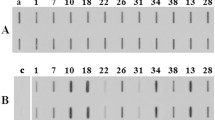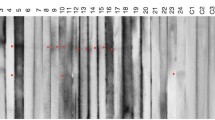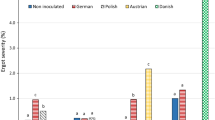Abstract
Ryegrass pollen (Lolium species) is a widespread source of air-borne allergens and is a major cause of hayfever and seasonal allergic asthma, which affect approximately 25% of the population in cool temperate climates. The main allergens of ryegrass pollen are the proteins Lol p 1 and Lol p 2. These proteins belong to two major classes of grass pollen allergens to which over 90% of pollen-allergic patients are sensitive. The functional role in planta of these pollen allergen proteins remains largely unknown. Here we describe the generation and analysis of transgenic plants with reduced levels of the main ryegrass pollen allergens, Lol p 1 and Lol p 2 in the most important worldwide cultivated ryegrass species, L. perenne and L. multiflorum. These transgenic plants will allow the study of the functional role in planta of these pollen proteins and the determination of potential for development of hypo-allergenic ryegrass cultivars.
Similar content being viewed by others
Abbreviations
- AFLP:
-
amplified fragment length polymorphism
- BAC:
-
bacterial artificial chromosome
- DIG:
-
digoxigenin
- GUS:
-
β-glucuronidase
- hph :
-
hygromycin phosphotransferase
- LG:
-
linkage group
- MES:
-
2-Nmorpholinoethanesulfonicacid
- PAGE:
-
polyacrylamide gel electrophoresis
- PBS:
-
phosphate-buffered saline
- PCR:
-
polymerase chain reaction
- PMSF:
-
phenylmethylsulfonyl fluoride
- RFLP:
-
restriction fragment length polymorphism
- SDS:
-
sodium dodecyl sulphate
References
Ansari A.A., Shenbagamurthi P. and Marsh D.G. 1989. Complete primary structure of a Lolium perenne (perennial ryegrass) pollen allergen, Lol p III: comparison with known Lol p I and II sequences. Biochemistry 28: 8665–8670.
Altpeter F. and Posselt U.K. 2000. Improved plant regeneration from cell suspensions of commercial cultivars, breeding- and inbred lines of perennial ryegrass (Lolium perenne L.). J. Plant Physiol. 156: 790–796.
Altpeter F., Xu J.P. and Ahmed S. 2000. Generation of large numbers of independently transformed fertile perennial ryegrass (Lolium perenne L.). plants of forage- and turf-type cultivars. Mol. Breed. 6: 519–528.
Bert P.F., Charmet G., Sourdille P., Hayward M.D. and Balfourier F. 1999. A high density molecular map for ryegrass (Lolium perenne) using AFLP markers. Theor. Appl. Genet. 99: 445–452.
Bhalla P.L., Swoboda I. and Singh B.M. 1999. Antisense-mediated silencing of a gene encoding a major ryegrass pollen allergen. Proc. Natl. Acad. Sci. USA 96: 11676–11680.
Bieber T. 1996. Fc epsilon R1 on antigen presenting cells. Curr. Opin. Immunol. 8: 773–777.
Bilang R., Iida S., Peterhans A., Potrykus I. and Paszkowski J. 1991. The 3’-terminal region of the hygromycin-B-resistance gene is important for its activity in Escherichia coli and Nicotiana tabacum. Gene 100: 247–250.
Cosgrove D.J., Bedinger P. and Durachko D.M. 1997. Group I allergens of grass pollen as cell wall-loosening agents. Proc. Natl. Acad. Sci. USA 94: 6559–6564.
Esch R.E. and Klapper D.G. 1989. Isolation and characterisation of a major cross-reactive grass group-1 antigenic determinant. Mol. Immunol. 26: 557–561.
Esch R.E. and Klapper D.G. 1989. Identification and localization of allergenic determinants on grass group-1 antigens using monoclonal antibodies. J. Immunol. 142: 179–184.
Ford S.A. and Baldo B.A. 1986. A re-examination of ryegrass (Lolium perenne) pollen allergens. Int. Arch. Allergy Appl. Immunol. 81: 193–202.
Freidhoff L.R., Ehrlich-Kautzky E., Grant J.H., Meyers D.A. and Marsh D.G. 1986. A study of the human immune response to Lolium perenne (rye) pollen and its components, Lol p I and Lol p II (rye I and rye II). I. Prevalence of reactivity to the allergens among skin test, IgE antibody, and IgG antibody data. J. Allergy Clin. Immunol. 78: 1190–1201.
Griffith I.J., Smith P.M., Pollock J., Teerakulpisut P., Avjioglu A., Davies S., Hough T., Singh M.B., Simpson R.J., Ward L.D. and Knox B.R. 1991. Cloning and sequencing of Lol p I, the major allergenic protein of ryegrass pollen. FEBS Lett. 279: 210–215.
Hamilton D.A., Roy M., Rueda J., Sindhu R.K., Sanford J. and Mascarenhas J.P. 1992. Dissection of a pollen-specific promoter from maize by transient transformation assays. Plant Mol. Biol. 18: 211–218.
Helliwell C. and Waterhouse P. 2003. Constructs and methods for high-throughput gene silencing in plants. Methods 30: 289–295.
Higo K., Ugawa Y., Iwamoto M. and Higo H. 1998. PLACE: a database of plant cis-acting regulatory DNA elements. Nucleic Acid Res. 26: 358–359.
Jauhar P.P. 1993. Cytogenetics of the Festuca-Lolium complex: relevance to breeding. Springer-Verlag, Berlin - New York.
Johnson P. and Marsh D.G. 1965. Allergens from common ryegrass pollen (Lolium perenne). The allergenic determinants and carbohydrate moiety. Immunochemistry 3: 101–110.
Jones E.S., Mahoney N.L., Hayward M.D., Armstead I.P., Jones J.G., Humphreys M.O., King I.P., Kishida T., Yamada T., Balfourier F., Charmet C. and Forster J.W. 2002a. An enhanced molecular marker-based map of perennial ryegrass (Lolium perenne L.) reveals comparative relationships with other Poaceae species. Genome 45: 282–295.
Jones E.S., Dupal M.D., Dumsday J.L., Hughes L.J. and Forster J.W. 2002b. An SSR-based genetic linkage map for perennial ryegrass (Lolium perenne L.). Theor. Appl. Genet. 105: 577–584.
Kahn C.R. and Marsh D.G. 1986. Monoclonal antibodies to the major Lolium perenne (rye grass) pollen allergen Lol p 1 (Rye 1). Mol. Immunol. 23: 1281–1288.
King T.P., Hoffman D., Lowenstein H., Marsh D.G., Platts-Mills T.A. and Thomas W. 1995. Allergen nomenclature. J. Allergy Clin. Immunol. 96: 5–14.
Knox B. and Suphioglu C. 1996. Environmental and molecular biology of pollen allergens. Trends Plant Sci. 1: 156–164.
Laffer S., Valenta R., Vrtala S., Susani M., van Ree R., Kraft D., Scheiner O. and Duchene M. 1994. Complementary DNA cloning of the major allergen Phl p I from timothy grass (Phleum pratense); recombinant Phl p I inhibits IgE binding to group I allergens from eight different grass species. J. Allergy Clin. Immunol. 94: 689–698.
Li L. and Cosgrove D.J. 2001. Grass group I pollen allergens (β-expansins) lack proteinase activity and do not cause loosening via proteolysis. Eur. J. Biochem. 268: 4217–4226.
Muller W.D., Karamfilov T., Bufe A., Fahlbush B., Wolf I. and Jager L. 1996. Group 5 allergens of timothy grass (Phl p 5) bear cross-reacting T cell epitopes with group 1 allergens of ryegrass (Lol p 1). Int. Arch. Allergy Immunol. 109: 352–355.
Ong E.K., Griffith I.J., Knox R.B. and Singh M.B. 1993. Cloning of a cDNA encoding a group-V (group-IX) allergen isoform from ryegrass pollen that demonstrates specific antigenic immunoreactivity. Gene 134: 235–240.
Perez M., Ishioka Y.G., Walkerm E.L. and Chesnut R. 1990. cDNA cloning and immunological characterization of the ryegrass allergen Lol p I. J. Biol. Chem. 265: 16210–16215.
Roberts A.M., Bevan L.J., Flora P.S., Jepson I. and Walker M.R. 1993. Nucleotide sequence of cDNA encoding the group II allergen of cocksfood/orchard grass (Dactylis glomerata), Dac g II. Allergy 48: 615–623.
Sambrook J., Fritsch E.F. and Maniatis T. 1989. Molecular Cloning a Laboratory Manual, 2nd edn. Cold Spring Harbor Laboratory Press, Cold Spring Harbor, New York, USA.
Sidoli A., Tamborini E., Giuntinis I., Levi S., Volonte G., Paini C., De Lalla C., Siccardi A.G., Barelle F.E., Galliani S. and Arosio P. 1993. Cloning, expression, and immunological characterisation of recombinant Lolium perenne allergen Lol p II. J. Biol. Chem. 268: 21819–21825.
Singh M.B., Hough T., Teerakulpisut P., Avjioglu A., Davies S., Smith P.M., Taylor P., Simpson R.J., Ward L.D. and McCluskey J. 1991. Isolation of cDNA encoding a newly identified major allergenic protein of rye-grass pollen: intracellular targeting to the amyloplast. Proc. Natl. Acad. Sci. USA 88: 1384–1388.
Singh B.M. and Bhalla L.P. 2003. Hypoallergenic derivatives of major grass pollen allergens for allergy vaccination. Immunol. Cell Biol. 81: 86–91.
Smart I.J., Tuddenham W.G. and Knox R.B. 1979. Aerobiology of grass pollen in the city atmosphere of Melbourne: effects of weather parameters and pollen sources. Aust. J. Bot. 27: 333–342.
Smith P.M., Ong E.K., Knox R.B. and Singh M.B. 1994. Immunological relationships among Group I and Group V allergens from grass pollen. Mol. Immunol. 31: 491–498.
Spangenberg G., Perez Vicente R., Oliveira M.M., Osusky M., Nagel J., Pais M.S. and Potrykus I. 1992. CMS system in Nicotiana: flower development, patterns of mitochondrial DNA and mitochondrial gene expression. Sex. Plant Reprod. 5: 13–26.
Spangenberg G., Wang Z.Y., Wu X.L., Nagel J. and Potrykus I. 1995. Transgenic perennial ryegrass (Lolium perenne) plants from microprojectile bombardment of embryogenic suspension cells. Plant Sci. 108: 209–217.
Spangenberg G.,Wang Z.Y., Heath R., Kaul V. and Garrett R. 1997. Biotechnology in pasture plant improvement: methods and prospects.. In: Proc XVIII Intl Grassland Congress, Vol. 3. Winnipeg and Saskatoon.
Spangenberg G., Wang Z.Y. and Potrykus I. 1998. Biotechnology in forage and turf grass improvement.. In: Frankel R., Grossman M., Linskens H.F., Maliga P. and Riley R. (eds), Monographs on Theoretical and Applied Genetics, Vol. 23. Springer Verlag, Berlin, Heidelberg, Germany, pp. 192.
Spangenberg G., Kalla R., Lidgett A., Sawbridge T., Ong E.K. and John U. 2001. Breeding forage plants in the genome era.. In: Spangenberg G. (ed.), Molecular Breeding of Forage Crops. Kluwer Academic Publishers, Dordrecht, The Netherlands, pp.1–39.
Stingl G. and Maurer D. 1997. IgE-mediated allergen presentation via Fc epsilon R1 on antigen presenting cells. Int. Arch. Allergy Immunol. 113: 24–29.
Tamborini E., Brandazza A., de Lalla C., Musco G., Siccardi A.G., Arosio P. and Sidoli A. 1995. Recombinant allergen Lol p II: expression, purification and characterization. Mol. Immunol. 32: 505–513.
Wang Z.Y., Nagel J., Potrykus I. and Spangenberg G. 1993. Plants from cell suspension-derived protoplasts in Lolium species. Plant Sci. 94: 179–193.
Wesley S.V., Helliwell C.A., Smith N.A., Wang M., Rouse D.T., Liu Q., Gooding P.S., Singh S.P., Abbott D., Stoutjesdijk P.A., Robinson S.P., Gleave A.P., Green A.G. and Waterhouse P.M. 2001. Construct design for efficient, effective and high-throughput gene silencing in plants. Plant J. 27: 581–590.
Xu H., Theerakulpisut P., Goulding N., Suphioglu C., Singh M.B. and Bhalla P.L. 1995. Cloning, expression and immunological characterization of Ory s 1, the major allergen of rice pollen. Gene 164: 255–259.
Ye X., Wang Z.Y., Wu X.L., Potrykus I. and Spangenberg G. 1997. Transgenic Italian ryegrass (Lolium multiflorum) plants from microprojectile bombardment of embryogenic suspension cells. Plant Cell Rep. 16: 379–384.
Author information
Authors and Affiliations
Corresponding author
Rights and permissions
About this article
Cite this article
Petrovska, N., Wu, X., Donato, R. et al. Transgenic ryegrasses (Lolium spp.) with down-regulation of main pollen allergens. Mol Breeding 14, 489–501 (2005). https://doi.org/10.1007/s11032-005-1011-6
Received:
Accepted:
Issue Date:
DOI: https://doi.org/10.1007/s11032-005-1011-6




